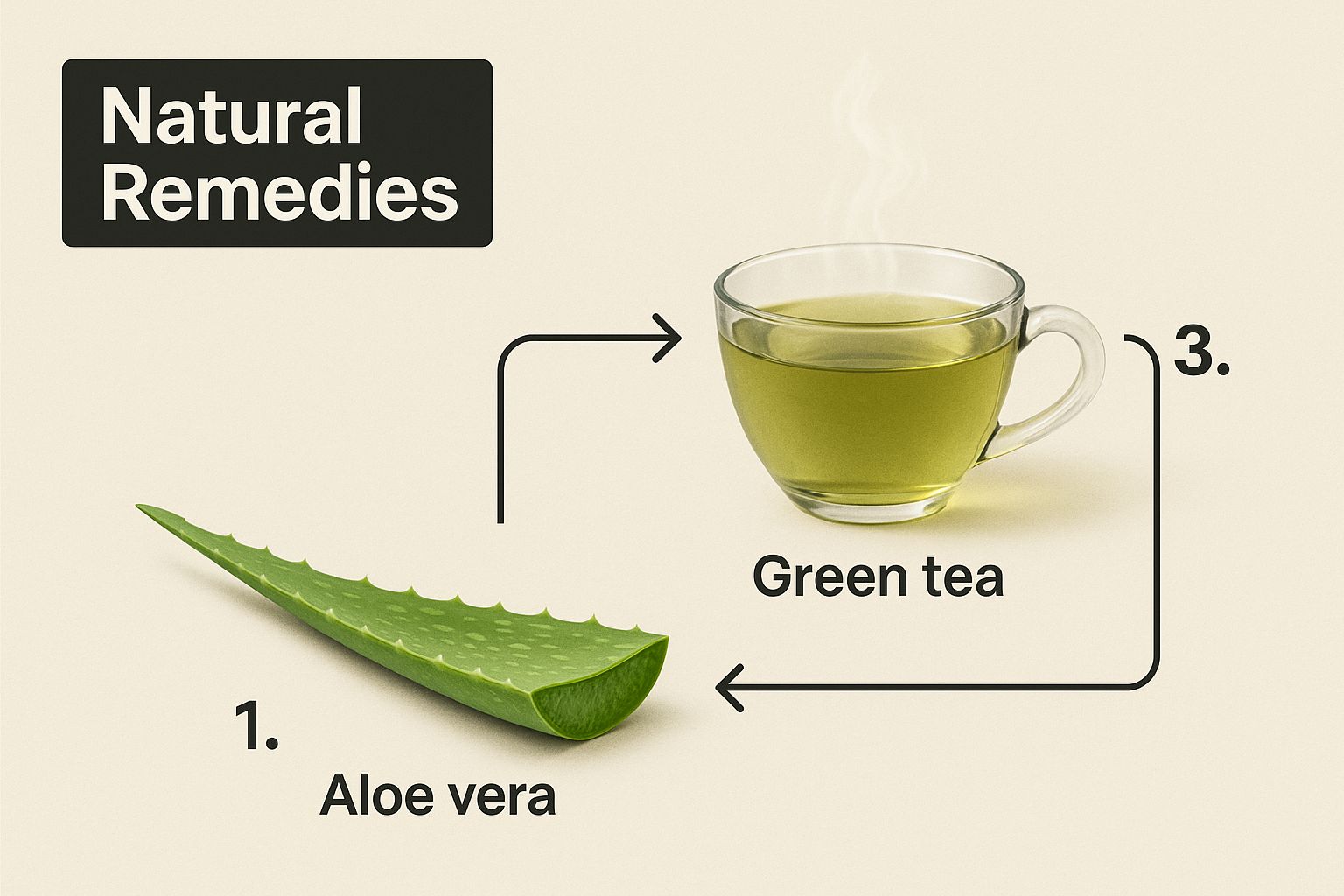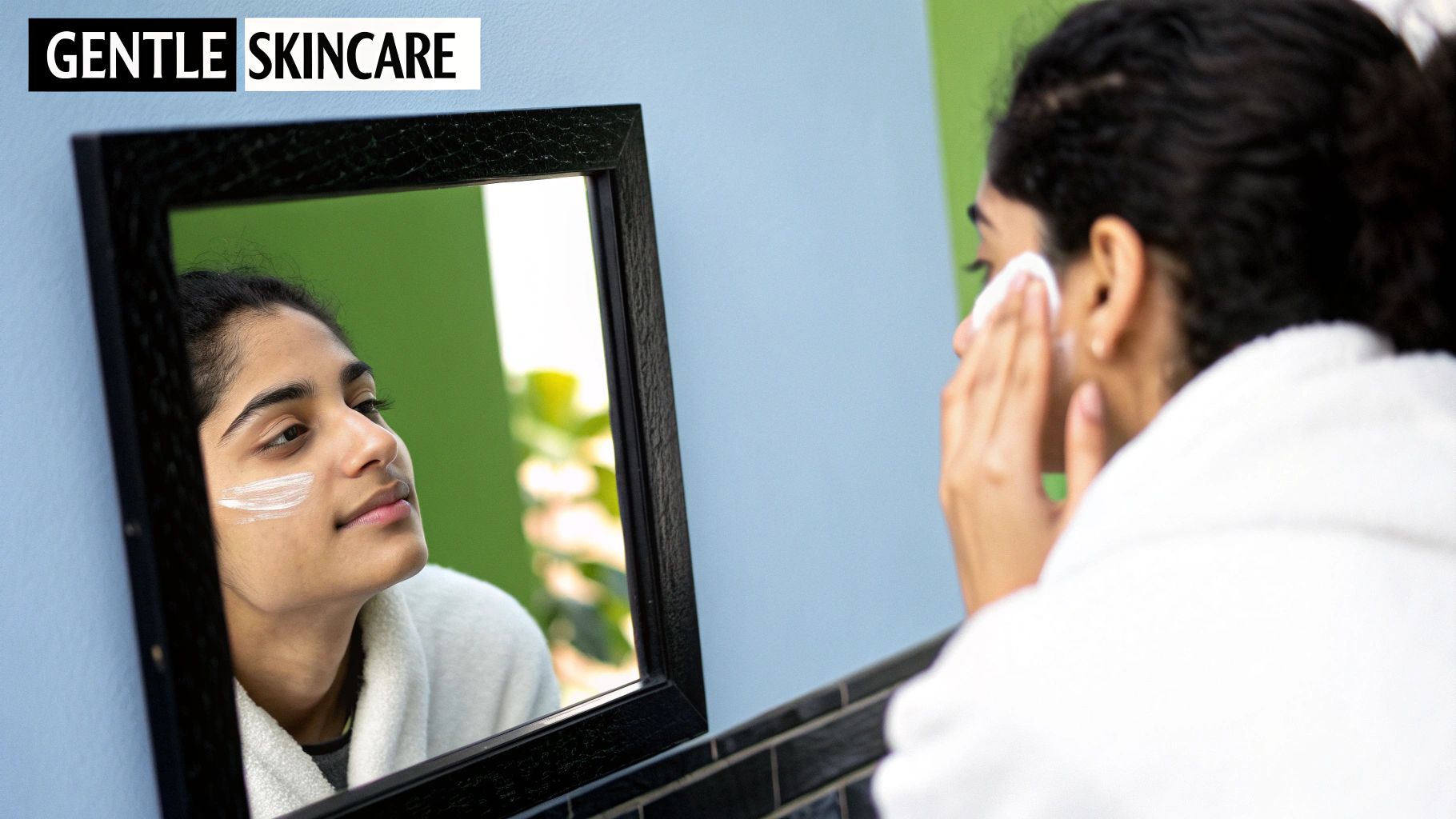
How to Treat Rosacea Naturally: Easy Tips & Remedies
Tackling rosacea from a natural standpoint is all about a two-part strategy. You've got to soothe your skin from the outside while also working to calm inflammation from the inside with smart diet and lifestyle choices. This isn't a quick fix; it's about becoming a detective, learning your personal triggers, and building gentle, consistent habits that strengthen your skin's defenses and keep those frustrating flare-ups at bay.
Getting to the Root of Rosacea Flare-Ups
Before you can really start making a difference, you need to know what you're up against. Rosacea is much more than just a bit of redness—it's a complex inflammatory condition with several distinct subtypes. What causes a flare-up for one person might be completely fine for another. This is why understanding your own skin is the real first step to getting things under control.
Think of yourself as an investigator for your own body. That flare-up that seems to have come out of nowhere? It almost always has a cause. Your mission is to connect the dots between your daily habits and how your skin reacts.
The Four Faces of Rosacea
It's important to know that not all rosacea is the same. When you can pinpoint your specific type (or types), you can be much more strategic and effective with your approach.
Erythematotelangiectatic Rosacea (ETR): This is the one most people picture. It involves that classic persistent redness across the face, easy flushing, and those tiny, visible blood vessels.
Papulopustular Rosacea: Often gets confused with acne because it brings on redness along with bumps and pimple-like blemishes (papules and pustules).
Phymatous Rosacea: This is a less common type where the skin thickens and takes on a bumpy texture. It most famously affects the nose, a condition known as rhinophyma.
Ocular Rosacea: This form focuses on the eyes. If your eyes are often red, irritated, watery, or feel like they have sand in them, this could be the culprit.
Keep in mind, it's very common to have symptoms from more than one type. Your experience is likely a unique blend.
Pinpointing Your Personal Triggers
The real secret to managing rosacea is figuring out what sets your skin off and then doing your best to avoid it. While everyone’s triggers are a little different, there are some well-known offenders. Sun exposure is a huge one for almost everyone, as is emotional stress and big swings in temperature—both hot and cold.
What you eat and drink can also play a major role. Spicy foods, alcohol (red wine is a frequent suspect), and even hot coffee or tea can cause a reaction by making blood vessels dilate. Sometimes, the very products you're putting on your skin are the problem.
The good news is that nature offers some powerful allies. Botanical extracts are showing incredible promise, and one standout is Chrysanthellum indicum.
Research has shown this plant extract can make a real difference. In a 12-week study, a cream with just 1% Chrysanthellum indicum extract significantly reduced redness and the overall severity of rosacea when compared to a placebo. If you're curious about the science, you can read the full study about Chrysanthellum indicum's benefits.
Building Your Anti-Inflammatory Rosacea Diet
The path to calmer skin often starts right on your plate. It's easy to forget, but what you eat can either fuel the flames of inflammation or give your body the tools it needs to cool things down. Learning to manage rosacea naturally means seeing food as a foundational part of your skincare routine—one that works from the inside out.
This isn't about deprivation or a diet that feels like a chore. It's about making smart, strategic choices that create a less inflammatory environment in your body. Certain foods, known as vasodilators, can trigger a flare-up by widening blood vessels and rushing blood to your skin's surface. This is exactly why a spicy meal or a glass of red wine can cause that all-too-familiar, immediate flush.
Foods That Calm and Soothe
Your mission is to load up on foods that actively fight inflammation. These aren't just good for you; they're powerhouses for strengthening your skin barrier, supporting a healthy gut, and keeping that persistent redness in check.
Omega-3 Fatty Acids: Think of these as your skin's best friend. Omega-3s are critical for building strong cell membranes and are known for their powerful anti-inflammatory effects. You'll find them in fatty fish like salmon and mackerel, but also in plant-based sources like walnuts, chia seeds, and flaxseeds.
Antioxidant-Rich Produce: A colorful plate is a happy plate—and happy skin. Brightly colored fruits and vegetables are loaded with antioxidants that help shield your skin from environmental stress. Go for leafy greens, broccoli, berries, and bell peppers.
Prebiotic Fibers: A healthy gut and calm skin are deeply connected. Prebiotics act as food for the good bacteria in your digestive system, helping everything run smoothly. Great sources include garlic, onions, asparagus, bananas, and whole grains.
Identifying Your Personal Trigger Foods
Here’s the thing about rosacea: it's incredibly personal. What causes a flare-up for someone else might be perfectly fine for you. The only real way to figure out your own unique triggers is with a temporary elimination diet. It’s a straightforward method to connect the dots between what you eat and how your skin reacts.
For a few weeks, try removing the most common culprits from your diet:
Spicy foods (think chili, cayenne, and hot sauce)
Alcohol (especially red wine)
Hot beverages (coffee and tea can be triggers due to temperature)
High-sugar foods and processed snacks
Certain dairy products
During this time, really pay attention. Is your skin less red? Calmer? After a few weeks, start reintroducing one food group at a time. Give it three days before adding the next one, and watch for any reactions. This methodical approach is the secret to building a diet that works for you long-term.
This process gives you the power to prevent flare-ups, not just react to them. You're no longer guessing; you're making informed choices based on what your body is telling you.
While you're working on your internal balance, you can support your skin from the outside, too. Complementing your dietary changes by exploring a collection of rosacea-friendly products can make a huge difference. A holistic approach that combines a smart diet with the right topical care is almost always the most effective path to a clear, comfortable complexion.
Calm Your Skin with Gentle Topical Remedies
While tackling rosacea from the inside out with diet is a fantastic long-term strategy, what you put directly on your skin can bring more immediate, targeted relief. The trick is to find remedies that genuinely soothe inflammation and rebuild your skin's delicate barrier, not strip it away. When you’re learning how to treat rosacea naturally, becoming a discerning reader of ingredient labels is your new superpower.
The skincare world can feel overwhelming, but a handful of natural ingredients have consistently proven their worth for calming the redness and sensitivity that come with rosacea. These aren't just old wives' tales; they work by taming inflammation, strengthening fragile blood vessels, and offering gentle hydration without causing more trouble.
Powerful Plant-Based Soothers
When your skin is flaring up and feeling reactive, turning to gentle, proven botanicals can change everything. Many of these have been used for centuries, and now we have the science to back up why they work so well.
Green Tea Extract: This isn't just for your teacup. Green tea is loaded with antioxidants known as catechins, which are potent anti-inflammatories. When applied to the skin, it can visibly reduce redness and helps shield your skin from the environmental triggers that often start a flare-up.
Niacinamide (Vitamin B3): If there’s one ingredient to know for rosacea, it’s this one. Niacinamide is a true superstar for strengthening the skin's barrier function. A stronger barrier holds onto moisture better and is more resilient against irritants, which ultimately means less redness and sensitivity for you.
Azelaic Acid: You can find this gentle powerhouse naturally in grains like wheat and barley. It's fantastic for reducing the inflammation, bumps, and pustules that can come with certain types of rosacea. It calms the skin down while also helping to even out your overall skin tone.
The single most important thing you can do before trying any new product is a patch test. Seriously. Dab a small amount behind your ear or on your inner wrist and give it a good 24-48 hours. This one simple step can save you from the misery of a full-face reaction.
This visual breakdown shows just how powerful some of these simple, natural ingredients can be for calming angry skin.

As the image highlights, sometimes the simplest ingredients, like aloe or green tea, are the most effective. They form the bedrock of a solid, natural topical routine for rosacea-prone skin.
Simple DIY Masks for Instant Calm
Sometimes you just need quick, soothing relief right now. A simple mask made from ingredients in your kitchen can be incredibly effective. One of my go-to combinations is colloidal oatmeal and raw honey. Oatmeal is famously anti-inflammatory, and raw honey is a natural humectant that draws in moisture while also having gentle antimicrobial properties.
Just mix two tablespoons of ground colloidal oatmeal with one tablespoon of raw honey, adding a splash of water to create a smooth paste. Apply it to clean skin and relax for 15 minutes before rinsing with lukewarm (never hot!) water.
While at-home masks provide wonderful temporary relief, they are one piece of a bigger puzzle. For those who also struggle with textural issues left behind by past inflammation, you might eventually explore professional treatments. You can learn more about options like microneedling for acne scars once your active rosacea is calm and well-managed. But for now, consistently using gentle topicals is the foundation for getting—and keeping—calm skin.
Making Lifestyle Adjustments to Minimize Flare-Ups

True, long-term relief from rosacea isn't just about what you put on your skin—it's woven into the very fabric of your daily life. While topicals and dietary changes are crucial, the small, consistent adjustments you make to your habits can make a staggering difference in how often and how intensely you flare. Learning how to manage rosacea naturally means becoming more attuned to your environment and your body's responses.
If there's one change that makes the biggest impact, it's this: committing to daily sun protection. Time and time again, UV radiation is identified as the number one trigger for rosacea flare-ups. This isn’t just a concern for beach days; the incidental sun you get driving your car or sitting by a window really does add up.
My strong recommendation is to stick with a mineral-based sunscreen that uses zinc oxide or titanium dioxide. These work by creating a physical barrier on top of your skin, which is much less likely to cause irritation compared to chemical sunscreens that get absorbed. Look for an SPF of 30 or higher, and make applying it every single morning a non-negotiable part of your routine.
Taming Stress for Calmer Skin
The connection between stress and skin is not just anecdotal; it's a well-documented physiological response. When you’re under pressure, your body pumps out hormones like cortisol, which can kick your skin’s inflammatory processes into high gear. For this reason, managing stress isn't a fluffy self-care extra—it's a core part of an effective rosacea management plan.
You don't need to block out hours for this. Even a few minutes of intentional calm can have a profound effect.
Mindful Moments: Start small. Just five minutes of mindfulness or focused deep breathing can reset your nervous system. If you're new to this, apps like Calm or Headspace are excellent guides. Or, you can simply close your eyes and focus on the sensation of your breath moving in and out.
Gentle Movement: Intense, sweaty workouts can be a trigger for many people with rosacea. Consider swapping them for more calming activities like yoga, tai chi, or even a leisurely walk. These lower stress hormones without causing you to overheat.
Prioritize Sleep: When you're sleep-deprived, your cortisol levels naturally spike. Aiming for a solid 7-9 hours a night gives your skin and body the downtime they need to repair.
It's important to remember that the goal isn't to eliminate stress—that's just not realistic. The real aim is to build a toolbox of coping mechanisms you can turn to when you feel that tension rising. This proactive approach can stop stress from snowballing into a painful flare-up.
Avoiding Physical and Environmental Triggers
Beyond sun and stress, a whole host of other physical factors can provoke redness and flushing. Your skin is already in a highly sensitive state, so treating it gently is non-negotiable. It's often the simplest changes that bring the most relief.
Take a moment to think about your routine. Do you wash your face with hot water in the shower? That blast of heat is a classic trigger because it dilates the blood vessels right at the surface of your skin. A simple switch to lukewarm water for cleansing both your face and body can make a huge difference.
Even the fabrics you wear can be a problem. Rough textures like wool can create friction and irritation. Whenever possible, choose soft, breathable fabrics like cotton, silk, or bamboo, especially for things that touch your face, like scarves and pillowcases.
Finally, try to be more aware of extreme temperatures. In the winter, that means not sitting directly in front of a roaring fire or space heater. In the summer, it means seeking out air-conditioning during the hottest part of the day. These conscious choices create a more stable, calm environment for your skin, giving it the chance to heal and thrive.
Using Supplements Strategically for Skin Health

While what you put on your skin is incredibly important, we can’t ignore what’s happening on the inside. True skin resilience is built from within, and this is where targeted supplements come into play. Thinking about how to treat rosacea naturally really means adopting a whole-body approach. The right nutrients can give your body the tools to fight inflammation at its source.
This isn't about grabbing a generic multivitamin off the shelf and hoping for the best. It's about being smart and choosing specific compounds that are known to support skin health and, more importantly, quiet the inflammatory responses that trigger rosacea flare-ups.
Start With Zinc to Calm Your Skin
If you’re only going to try one supplement, make it zinc. I often recommend it because this essential mineral is a powerhouse for supporting the immune system and has well-documented anti-inflammatory properties. For rosacea, this is huge.
It’s not just anecdotal, either. Clinical research backs this up. One double-blind, placebo-controlled trial gave participants 100 mg of zinc sulfate daily and found it significantly reduced rosacea symptoms compared to the placebo group. You can read more about zinc's role in rosacea treatment on naturemed.org to see the data for yourself.
An important takeaway from that same research: be wary of high-dose niacin (vitamin B3) supplements. While its cousin, topical niacinamide, is a superstar for skin, taking niacin orally can actually make flushing worse for many people with rosacea.
Connect the Dots: The Gut-Skin Axis
Beyond zinc, two other key players can make a world of difference: omega-3 fatty acids and probiotics. They work together to address internal inflammation from different angles, creating a powerful foundation for a calmer complexion.
Omega-3 Fatty Acids: Whether from fish oil or flaxseed oil, these are incredible at reducing systemic inflammation. Think of them as reinforcing your skin from the inside out. They help strengthen cell membranes, which in turn leads to a more resilient skin barrier that isn't so easily irritated.
Probiotics: I can't stress this enough—a happy gut often leads to happy skin. Probiotics introduce beneficial bacteria to your digestive system, which helps regulate immune responses that can show up on your face as inflammation and redness. When you're shopping for one, look for a supplement that offers a good variety of different strains.
Now, before you run out and buy everything, a quick but crucial reminder: always talk to your doctor before starting a new supplement routine. They can help you figure out the right dosages and make sure nothing will interfere with other medications or health conditions. Getting that professional green light is just smart.
Once you have your internal and topical routines dialed in and the active inflammation is under control, you might want to address any leftover concerns. Things like lingering redness or textural changes can often be improved with professional treatments. For instance, a chemical peel can offer transformative results and is worth looking into as a next step in your skin journey.
Your Top Questions About Natural Rosacea Care, Answered
When you first start exploring natural ways to manage rosacea, it’s completely normal to have a flood of questions. It's a new path, after all. Getting solid answers is what keeps you going, especially on those days when you're wondering if all this effort is really making a difference.
So, let's tackle some of the most common questions I hear from people just like you.
"How Long Until I Actually See Results?"
This is probably the number one question on everyone's mind. When you've committed to big changes, like overhauling your diet, you want to know it's working.
You might notice small wins within a few weeks—things like a little less background redness or waking up with fewer new pustules. But for the really deep, lasting changes, you need to play the long game. It realistically takes about 2-3 months of consistent effort for your body's overall inflammation to cool down. Only then will your skin truly start to reflect that new, calmer internal environment. Patience here is everything.
"Can I Combine Natural Remedies with My Prescription Cream?"
That's a fantastic question, and the short answer is often yes. In fact, many natural approaches can be the perfect partner to conventional medicine. Think about it: using a super gentle, soothing skincare routine and sticking to an anti-inflammatory diet creates the ideal foundation for any prescription topical your dermatologist gives you.
The key, however, is to be completely open with your doctor. This is non-negotiable. While a calming oat-based moisturizer is one thing, some herbal supplements can interact with medications. Always loop in your healthcare provider so they can help you build a smart, integrated plan that gets the best of both worlds.
The goal isn't to replace one with the other, but to create synergy. Your lifestyle and diet changes create the best possible canvas for your medical treatments to do their job effectively. This teamwork is what truly unlocks the best results.
"What Do I Do If I Still Get a Flare-Up?"
First, breathe. Flare-ups are going to happen. They are not a sign that you've failed or that this approach isn't working. Remember, the goal of natural management isn't a flawless complexion 100% of the time; it’s about having fewer flare-ups, making them less severe, and helping your skin bounce back faster.
When a flare-up does strike, it's time to put on your detective hat. Don't throw your hands up in defeat; get curious. Ask yourself a few simple questions:
What did I eat yesterday? Did a known trigger sneak in?
Was I under a lot of stress?
Did I get more sun exposure than I planned for?
Did I try a new product—even just once?
Figuring out the "why" is so empowering. It gives you another piece of your personal rosacea puzzle and helps you fine-tune your strategy moving forward. During the flare itself, just go back to basics. Strip your routine down to your gentlest products, focus on hydration inside and out, and eat simple, soothing foods until things calm down. This calm, proactive response is the heart of managing rosacea for the long haul.
At Olive Skin Therapy, we're firm believers that the best approach is a personal one that gets to the root cause of your skin's behavior. Olivia Codd's deep expertise in creating customized treatment plans can give you the professional guidance you need on your journey to calmer, healthier skin. Let's explore how a tailored strategy can enhance your natural efforts and bring you lasting relief.
Book your customized skincare consultation at Olive Skin Therapy today!
